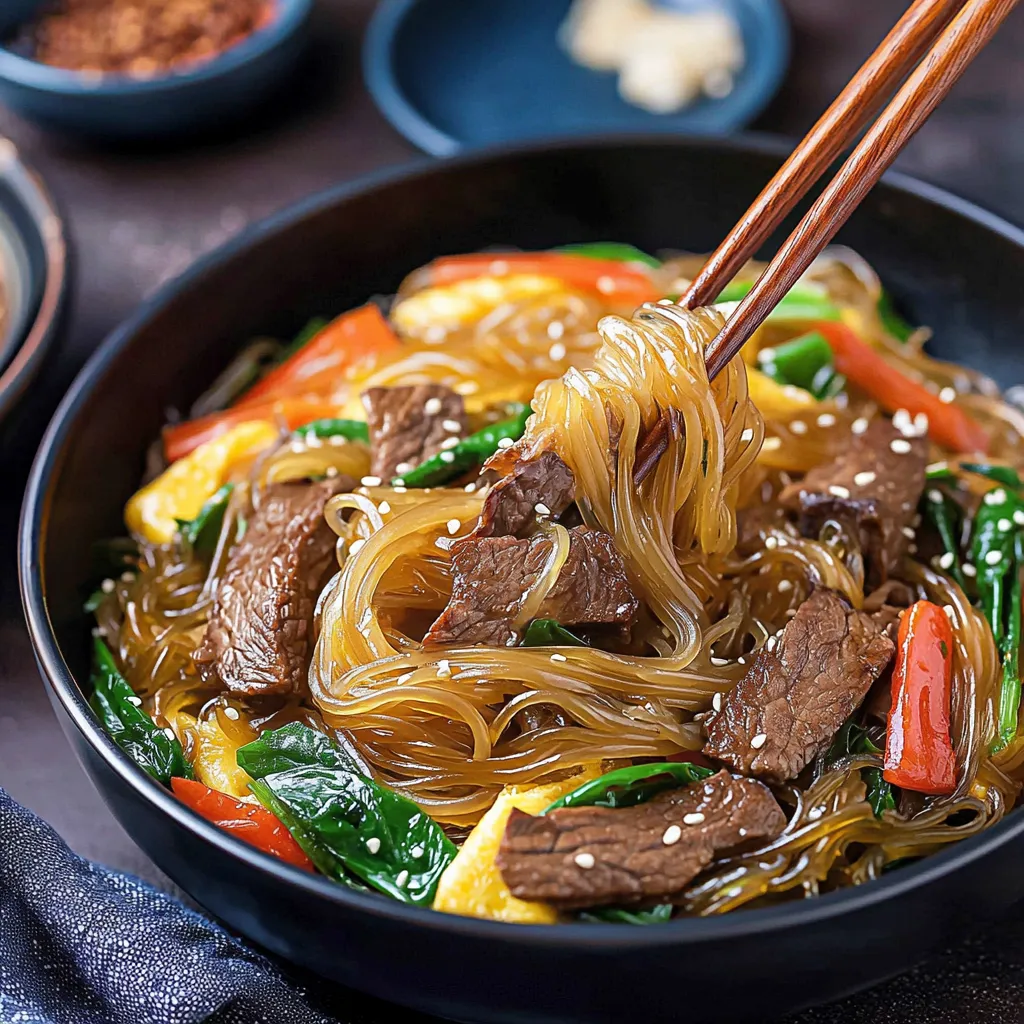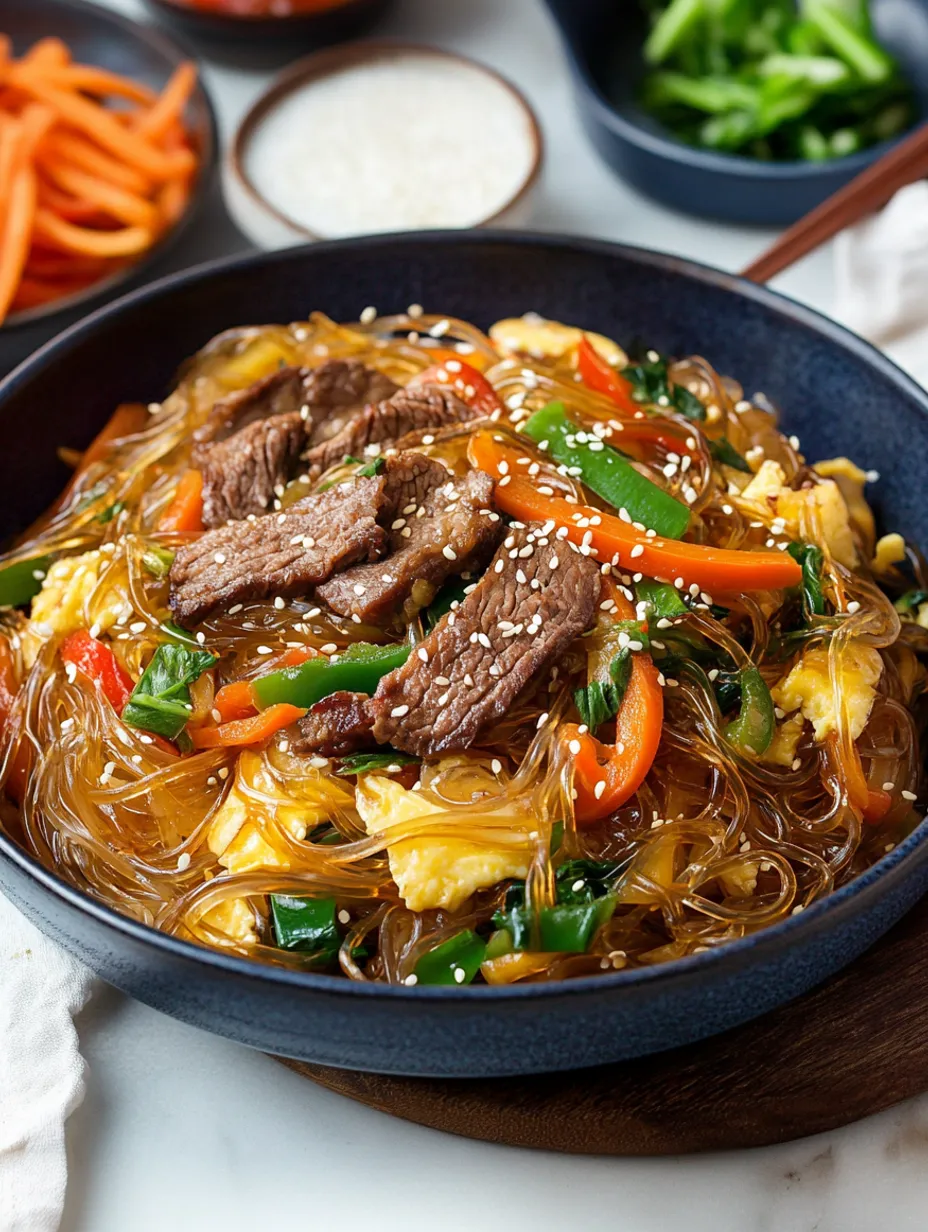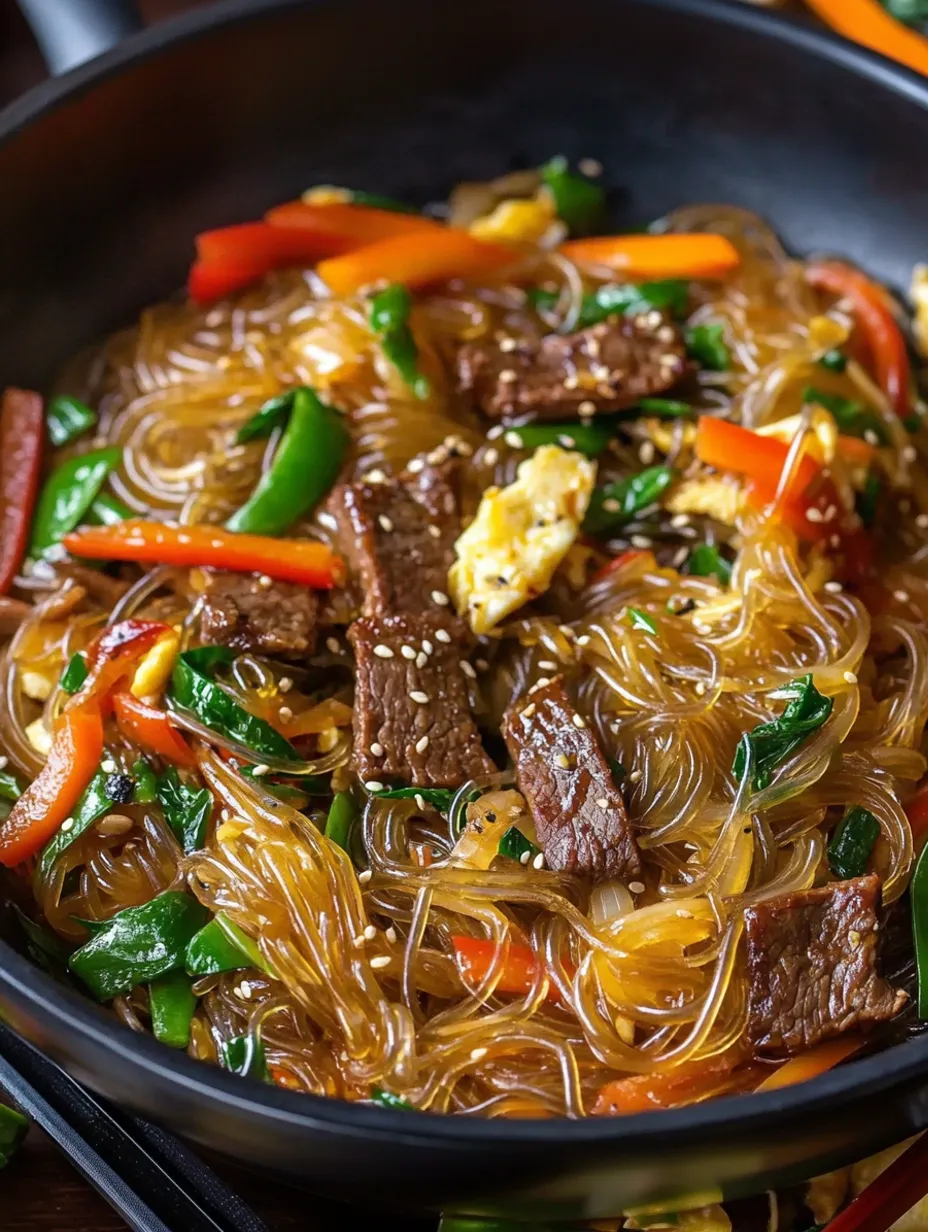 Pin it
Pin it
I discovered Korean Japchae last year when I was trying to branch out from my usual stir-fry routine, and it's completely changed my weeknight dinner game! These sweet potato glass noodles have this amazing chewy-springy texture that's unlike any other pasta I've tried, and they soak up that savory-sweet sauce in the most incredible way. What I love most is how the dish balances so many flavors and textures - from the tender marinated beef to the rainbow of crisp-tender veggies, all tied together with that umami-packed sauce that hits every taste bud.
I made this for my friend who spent a year teaching in Seoul, and she said it was the closest thing to what she ate there that she's had since coming back. That's when I knew I'd nailed the recipe!
Perfect Ingredients
Noodle Know-HowSweet potato glass noodles (dangmyeon) are absolutely essential - no substitutes will give you that signature chewy-springy texture. They might look intimidating, but they cook up in minutes and are actually pretty forgiving. Find them in the Asian section of well-stocked grocery stores or at any Asian market. They come in those distinctive dark gray-purple bundles that transform to glassy clear when cooked.
Beef BrillianceBoneless short ribs are the secret to restaurant-quality Japchae - they have the perfect balance of lean meat and fat. Slice them super thin against the grain for maximum tenderness. The marinating time really matters - even 30 minutes makes a big difference in flavor. If you can't find short ribs, ribeye makes a decent substitute.
I tried making this once with regular rice noodles when I couldn't find sweet potato noodles, and while it was still tasty, it definitely wasn't Japchae. Those distinctive glass noodles are truly irreplaceable - they have this uniquely chewy texture that soaks up sauce like nothing else. It's worth seeking them out!
 Pin it
Pin it
Simple Preparation
Noodle PrepStart by cooking the glass noodles - they only need a few minutes in boiling water, then a quick drain and rinse with cold water to stop the cooking. The key is tossing them with half the sauce while they're still warm - they'll soak up all that flavor like tiny sponges, which is what gives the dish so much depth. Don't worry if they seem a bit firm; they'll continue softening as they sit.
Cooking OrderThe secret to perfect Japchae is cooking each component separately to ensure everything is cooked just right. After the noodles, make the egg pancake (it's easier than it sounds - just pour whisked eggs into a hot pan and let them set without stirring), then slice it into thin strips. Next come the vegetables, in a specific order based on cooking time - carrots first since they're the hardest, then bell peppers and onions, followed by mushrooms, green onions, and finally the spinach which needs just seconds to wilt.
Final AssemblyThe beef goes in the pan last, giving it a quick sear to keep it tender. Then everything gets tossed together in a big bowl with the remaining sauce. This method ensures each ingredient maintains its distinct texture and flavor while still blending harmoniously in the final dish. A sprinkle of green onions and sesame seeds adds the perfect finishing touch.
I learned through trial and error about the importance of cooking each component separately. The first time I made this, I threw everything in the pan together and ended up with overcooked noodles, mushy vegetables, and tough beef. Now I know that taking the extra few minutes to cook things in stages makes all the difference in the final texture.
My first attempt at Japchae was tasty but not quite right because I skipped the gochujang, thinking it would make the dish too spicy. In reality, it adds a complex, slightly sweet heat that's essential to the authentic flavor. Even if you're spice-sensitive, a small amount makes a big difference without making it too hot.
Perfect Pairings
Japchae is substantial enough to be a complete meal on its own, but if you want to create a Korean feast, there are some wonderful dishes to serve alongside it. A small bowl of kimchi adds a spicy, fermented contrast that cuts through the richness of the noodles. Quick-pickled vegetables like radishes or cucumbers provide a refreshing crunch and palate-cleansing acidity. For a simple weeknight meal, I sometimes just add a fried egg on top - the runny yolk creates an instant sauce that takes the dish to another level. And don't forget a cold beer or some makgeolli (Korean rice wine) for the perfect beverage pairing! If I'm serving this for guests, I'll often set out small dishes of extra gochujang, toasted sesame seeds, and sliced green onions so everyone can customize their bowl to taste.
 Pin it
Pin it
Chef's Notes
Temperature Matters: Have all your ingredients prepped before you start cooking - this stir-fry moves quickly! Sauce Secret: Tossing the noodles with sauce while they're still warm helps them absorb maximum flavor. Veggie Timing: Follow the exact order of cooking vegetables - it ensures everything is perfectly crisp-tender.
This Japchae recipe has become one of my absolute favorite dishes to make when I want something that feels special but doesn't require hours in the kitchen. There's something so satisfying about the combination of those uniquely chewy noodles, savory beef, and colorful vegetables all coated in that perfect umami-packed sauce. It's the kind of meal that makes you feel like you're dining at a restaurant even though you're in your pajamas at home - and isn't that the ultimate cooking win?
Frequently Asked Questions
- → Can I make Japchae vegetarian?
- Absolutely! Simply omit the beef and add more mushrooms or tofu for protein. The dish is just as delicious without meat.
- → Where can I find glass noodles?
- Look for sweet potato starch noodles (dangmyeon) in Asian grocery stores or in the international aisle of well-stocked supermarkets.
- → Can I make Japchae ahead of time?
- Yes! It actually tastes even better the next day. Store in an airtight container in the fridge for up to 3 days.
- → What if I don't have a wok?
- A large skillet works perfectly fine. Just make sure it's hot before adding ingredients to get a good sear.
- → Is Japchae spicy?
- Traditional Japchae is mild, but you can adjust the heat by adding more or less gochujang or sriracha to suit your taste.
